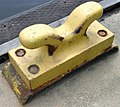Mooring line
Mooring lines are lines or cables (also: ropes ) that are used to fasten a ship to bollards on the quay , pier or another ship.
Names of the lines
Common are:
- Forward line or bow line.
- Stern line or stern line.
- Fore jump (diagonally on the side of the ship from bow to stern )
- Aft jump (diagonally on the side of the ship from stern to bow )
In addition, chest lines or cross lines can be attached to keep the ship close to the dock. Fenders are attached between the boat and the dock so that the hull is not damaged by the ship's movements on the dock.
- Front line - double front line - fore spring - stern line - aft spring
Pre-lines of Lech stone ( NDL )
Bayernstein fixed with double bow lines ( Hapag-Lloyd )
Leading edge of the HSDG container ship Rio Blanco
Anchor chains do not count as mooring lines.
application
Throw line
To bring the sometimes thick, heavy mooring lines ashore, a throw line can be used, which is weighted down at one end with a small sand-filled leather bag, throw line knot or a monkey fist .
Laying the lines
The lines are usually on a ashore bollard occupied . For this purpose, a large eye is firmly spliced into one end of the mooring line and is often covered with leather or fabric to protect against abrasion.
Smaller ships are occupied on bollards, rings or cleats (see occupancy on the cleat ). The most frequently used knots are the bowline , the weaving line , the round turn with two half twists and the Roringstek .
On board boats the mooring lines are moored on a cleat. On large ships, the mooring lines are tensioned with a cable winch and placed on a double bollard.
Shock absorption
So that the ship lies as calmly as possible even in rough seas and the ship's movements are dampened, either square braided cordage is used, which has a high level of damping due to this type of braiding and is very easy to handle. On the other hand, twisted (twisted) cordage is used, which is more elastic than normal braided cordage (has more " bar "). On yachts, the mooring lines are not tightly tensioned, but always sag slightly so that the ship can move a little in rough seas. In the case of small boats, shock absorbers made of hard rubber or in the form of a steel spring are also used at the berth . A double “ slip ” mooring line has twice as much attenuation as a single one.
An alternative to the mooring line is a hydraulic boat lift for smaller boats. So the boat is not exposed to the tides and the waves.
Rat repellent
Mooring lines are one way rats can get on board in ports . Therefore, if necessary, a rat sheet is attached to each mooring line .
material
Mooring lines should be particularly shock-absorbing, tear-resistant and ideally buoyant. These properties are not fulfilled by the available materials at the same time. Polyamide (nylon) is particularly elastic, polyester is particularly tear-resistant, and polypropylene is buoyant . A special method of braiding helps to make less elastic material more elastic: the 8-fold square braiding in combination with polyester results in high-strength elastic mooring lines, which are also very soft to handle and do not form kinks (twisted ropes).
literature
- Seamanship. Yachting manual. 30th edition, Delius Klasing Verlag , Bielefeld 2013, ISBN 978-3-7688-3248-9 , u. a. Pages 198ff
- Joachim Schult: Sailors Lexicon . 13th edition. Delius Klasing, Bielefeld 2008, ISBN 978-3-7688-1041-8 . , Keywords mooring ropes , mooring stanchions , spring











